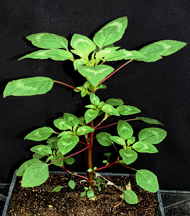New publication to help farmers control Palmer amaranth weed
May 29, 2013
 |
|
Palmer
amaranth, a weed that has caused widespread problems for crops in the southern
United States, is spreading to northern states. It has been seen as far north
as Indiana and Michigan. (Purdue Department of Botany and Plant Pathology
photo/Travis Legleiter)
|
WEST LAFAYETTE, Ind. - A new publication on Palmer amaranth, one of the most aggressive weeds to compete with crops, is now available for free through Purdue Extension's The Education Store.
Palmer Amaranth Biology, Identification and Management was created by Purdue Extension weed scientists Bill Johnson and Travis Legleiter in an effort to curb the weed's expansion to the northern U.S. The 11-page publication can be downloaded at http://www.the-education-store.com, where it can be found by searching for "WS-51." Print copies can be ordered for $2.10 each, plus shipping and handling.
"We're very concerned about the competiveness, the seed production and the impact Palmer amaranth can have on Midwest crops," Johnson said. "We feel this is a weed we really need to get on top of before it becomes very widespread."
Palmer amaranth is a green, hairless, flowering weed with multiple seed heads.
"It's arguably the worst weed problem to hit agronomic crops in the southern United States," Johnson said. "We've watched cotton fields being mowed down before harvest because of Palmer amaranth."
In recent years, Palmer amaranth has spread north to Indiana, Ohio, Illinois and Michigan, and both Legleiter and Johnson want farmers to know the potential threat it poses to crops. They are most concerned with how this weed could affect area soybeans.
"We have a number of herbicides that we can use in corn to control it, but in soybeans we're really limited on the number of herbicides we have to control it because most populations are going to be resistant to both glyphosate and ALS - acetolactate synthase," Johnson said.
The publication offers management recommendations based on research from the South and Michigan State University since this is a relatively new problem in Indiana.
Farmers should rotate crops so they can use additional herbicides that may work for corn but not beans, practice deep tillage to bury Palmer amaranth seeds, and monitor field ditches and borders for weed emergence.
Johnson and Legleiter recommend farmers use a multipronged management approach to control this weed because it is highly adaptable and has a high chance of survival.
"Bad control in one year can lead to a lifetime of problems because of the amount of seed it can produce, Johnson said.
Writer: Amanda Gee, 765-494-8402, agee@purdue.edu
Sources: Bill Johnson, 765-494-4656, wgj@purdue.edu
Travis Legleiter, 765-496-2121, tlegleit@purdue.edu
Ag Communications: (765) 494-2722;
Keith Robinson, robins89@purdue.edu
Agriculture News Page

